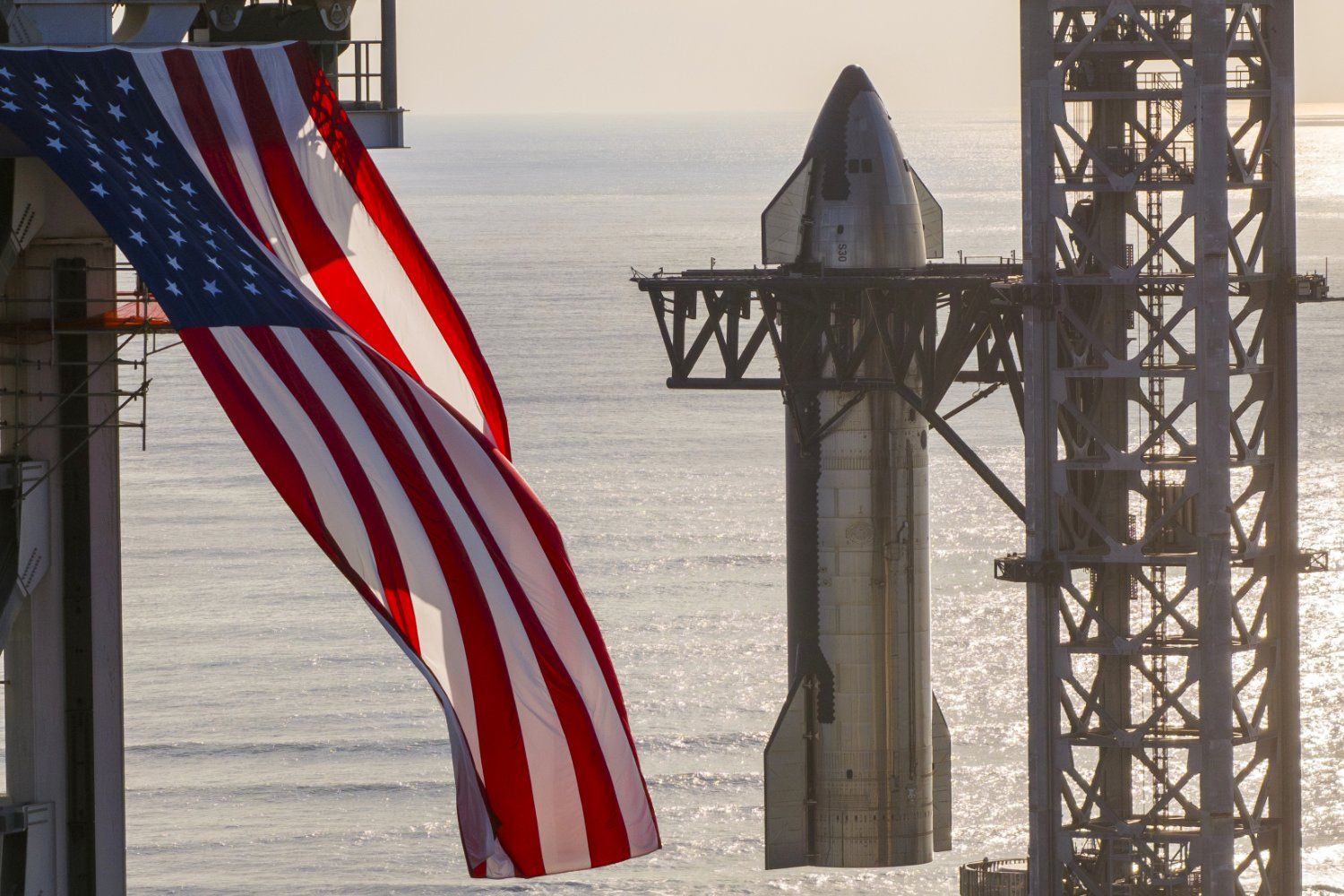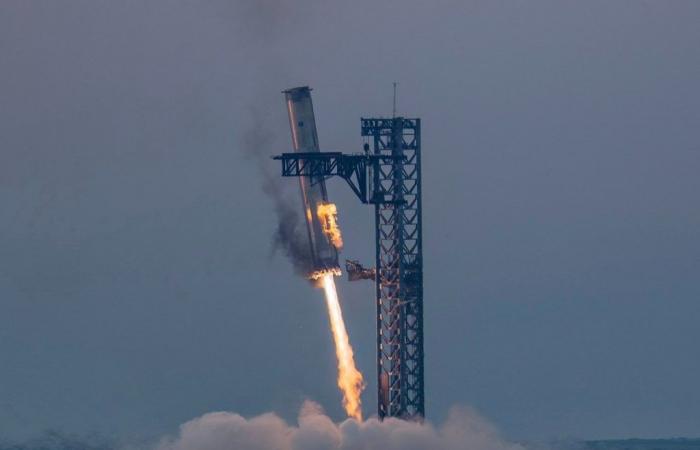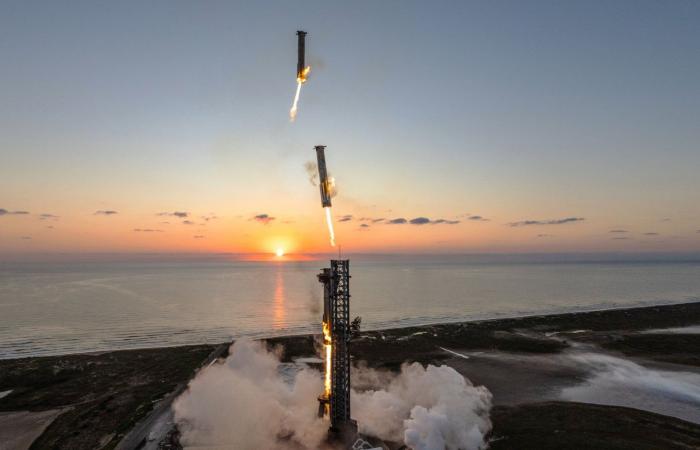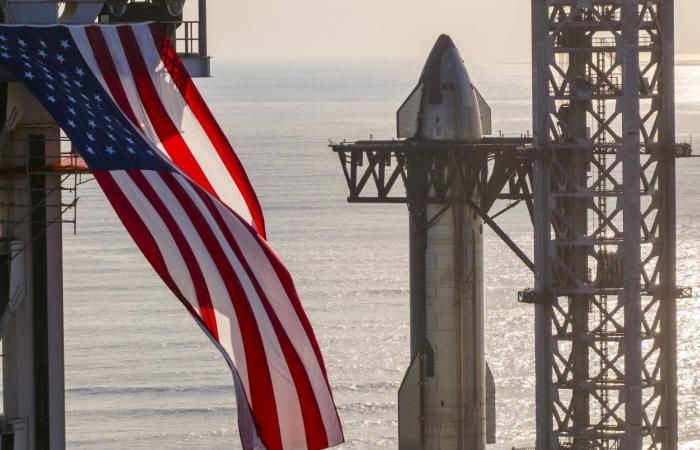In 2020, Elon Musk spoke for the first time about “Mechazilla”, the stage name of a mysterious 122-meter tower, capable of taking off a gigantic rocket – larger than Saturn V – and then catching up with it , once its first stage returns to Earth. Rather than letting the launchers take their feet out and land on their own, the boss of SpaceX wanted to go further, in a much more serious project than he let on.
Two years later, in 2022, the first images of this extraordinary tower were discovered. We then saw Elon Musk, his head thrown back, discovering the unique perspective of “Mechazilla”, raised to 145 meters, and its four “wands”, capable according to him of closing on Super Heavy, the Starship launcher. A first glimpse of a new infrastructure, even though Super Heavy was still unable to take off without exploding, at the same time.
However, it only took SpaceX two years. A very short delay, on the scale of the impressive feat that the biggest heavy thrower in history has just achieved, last Sunday, October 13. Facing a sunrise over the Gulf of Mexico, from “Starbase” in Boca Chica (Texas), the aerospace company carried out the fifth test, and was able to catch up with the first stage, without it missing its target , or that it explodes first.
The images went around the world. For a short moment, which nevertheless represents tens of kilometers of distance, the first stage of the Super Heavy / Starship rocket descended from an altitude of more than 70 kilometers to return to its launch pad. In images, a real 70-meter building, propelled at supersonic speed, and 13 of the 33 “Raptor” engines restarted at the last moment to brake and guide this behemoth with a precision of just a few tens of centimeters.
The 3 advantages of catching up with a rocket
More than one showthe maneuver carried out by SpaceX gives it a considerable advance, which competing companies and even opposing powers like China would like to match. Catching up with a rocket will open the way to new uses, a reduction in costs, an increase in the capabilities of sending loads into space and finally, for NASA and Artemis, new perspectives in future trips to the Moon and beyond. March.
Cost reduction
“In order for us to quickly reuse the rocket, we need to return it faster”declared a SpaceX spokesperson last Sunday. “There is nothing faster than bringing the launch vehicle directly to the launch site”he added, taking up the original idea of Elon Musk, who saw in 2022 being able to take off a rocket again just an hour after catching up. From now on, the boss of SpaceX is working on a deadline shortened to 30 minutes.
With the launches of Falcon 9, SpaceX’s commercial rocket, it takes twenty days for the entire rocket to take off again. Between being picked up by a crane, transported to the launch site and reintegration with the second stage, all before returning to the launch pad, a rocket has never been designed to be ready for use once again after takeoff, without any crazy logistical organization.
By this simple fact, being able to manage everything from the same point, in this case the Boca Chica launch pad in south Texas, will allow SpaceX to save a lot of money and time. It will obviously be necessary for everything to work perfectly, and for the launch pad not to be damaged by the engines or by the plasma of the rocket’s supersonic speeds. In which case, everything would be much more expensive for the company, which would also end up losing its launcher, which would crash to the ground.
Weight reduction
To understand why SpaceX has worked over the last four years on a system of grippers that would allow its rockets to catch up, we also have to talk about weight. It’s hard to imagine that a behemoth like Super Heavy – the world’s largest space launcher – would have anything to do with a few pounds more or less. And yet. If the latter can claim more than 200 tonnes, far from the 22 tonnes of a Falcon booster, it is also because SpaceX thought of Mechazilla.
Its giant arm will thus allow Super Heavy to not seek to have a landing system like on the Falcon boosters. With such a mass, it would ultimately be much more dangerous to try to land such a colossus than to have it reach a base, which would close in on it and cushion the blow when the engines definitively shut down. Raptor. The images reaching us from the tower allow us to see the tipping point, when the mass of Super Heavy is transferred from the thrust of the engines to the gripper systems.
If the launcher is particularly heavy, it is because it must, in the future, represent the one which will be able to launch women and men towards the Moon and towards Mars, but also payloads in orbit, much more imposing than today’s satellites. So in the same way, not having landing legs for the launcher allows it to leave hundreds of additional kilos to take into space, which SpaceX today estimates between 100 and 150 tonnes. Far from the 22.8 tonnes of Falcon 9 or the 21 tonnes of Ariane 6, which the two rockets can only carry into low orbit.
Land and take off, from anywhere
Whether for Earth, Mars or the Moon, Starship must expand the range of possibilities in terms of takeoff and relaunch. And this will involve the need to be able to go anywhere, without requiring a flat surface, having a firing point and all the infrastructure that follows. With a tower like Mechazilla, SpaceX puts forward the advantage of no longer needing to prepare the ground and make it flat.
“When you think about the Moon, Mars and other regions, you don’t necessarily have flat surfaces everywhere”explained to Barron’s site André Chanin, CEO of ProcureAM, which manages the ETF specializing in space companies, Procure Space. With its diameter of 9 meters, much more than the infrastructure planned for Falcon 9 on Earth will be required for the SpaceX super-rocket which will later participate in the Artemis program for the Moon, and for Mars. What’s more, an installation like that of Mechazilla, despite its extraordinary dimensions, seems simpler to set up elsewhere… than on Earth.
Note, however, that in the Artemis program, there is no question with NASA of landing the Super Heavy first stage on lunar soil. The latter will instead return to Earth, and it is the Starship spacecraft which will embody the lunar lander, during the Artemis III mission supposed to take place in 2026, to deposit astronauts on the surface of the satellite, for the first time since 1972 and Apollo 17.
What next for Super Heavy, Starship and Mechazilla?
Put out the fire
Sunday October 13, when SpaceX’s heavy launcher reached an altitude of 71 kilometers and separated its first stage, it turned towards a new mission phase never before carried out. The fifth test flight of the Super Heavy / Starship rocket, modified in passing compared to the fourth flight, was planning a new mission phase. But despite the successful catch-up, SpaceX had to suffer several failures.
The most visual of these concerns a fire, declared on the fuel supply column. After restarting 13 of its 33 Raptor engines, the first stage was the subject of flames, which continued for long seconds after landing and the complete shutdown of the rocket. Before making the final braking, we could also observe several pieces of debris escaping. On X, Elon Musk finally confirmed the deformation of the nozzles of the outer ring of the engines, due to violent friction with the atmosphere.
A week after the flight, Elon Musk spoke again on He then confirmed the deformation of the engine nozzles “and other minor issues”specifying that it would be “easy to solve”. The boss of the aerospace company took the opportunity to recall the interest of the launch pad and of catching up with the rocket.
“The thruster returns within 5 minutes of takeoff, so the remaining time is spent reloading the thruster and placing a new vessel.”

To solve the Raptor engine problem, SpaceX is working on their third generation. The company presented them for the first time last August. Radically simplified compared to the first and second generation, these future Raptor 3s are presented as more resistant to heat, but also more efficient and more economical. In short, they will be SpaceX’s new toys for future attempts to return to the Super Heavy first stage launch pad.
Rattraper Starship
While waiting for these new engines, SpaceX does not intend to waste time and will repeat the experience of catching up with Mechazilla “early next year”wished Elon Musk in a post published on X. Yes, but this time, there will be no question of Super Heavy. The boss of SpaceX intends instead to turn to Starship, and the recovery of the 50 meter high vessel, which will simulate many other imaginable scenarios like those mentioned above, with the Moon and Mars.
On Earth, a catch-up of the ship will revive one of the first dreams imagined by Elon Musk with Starship, namely “point-to-point transportation”. On its site, SpaceX continues to mention this possibility in the description of Starship, with the promise of being able to connect any region of the world in less than an hour. From a capacity point of view, the Starship is supposed to be able to accommodate up to 100 people on board, or to load cargo in a volume of more than 1000 m3.

Despite everything, the future Starship test flight is difficult to envisage for the beginning of 2025. Because it will require moving Super Heavy elsewhere than on the launch pad. The FAA, the American civil aviation police, could also block SpaceX while to return to Starbase, the Starship will have to complete a complete tour of the Earth and therefore arrive from the west, and fly over habitable zones. Despite the success of Super Heavy’s first shot, the recovery maneuvers on the launch pad are still in their early stages, with much more risk than a big dive into the ocean.
A real leap into the void, therefore, from the point of view of aerospace history, for a project whose engineers will have to aim just so as not to miss the launch point. From there, the new era of fully reusable rockets will be formally launched immediately. On the other side of the Pacific, in China, it will still be more than 10 years before the technologies reach such maturity. Across the Atlantic, in Europe, the idea of catching up with the rockets is not considered.
???? To not miss any news from 01net, follow us on Google News and WhatsApp.









